Part of the learning curve for me getting into the aquarium hobby was familiarizing myself with water quality parameters. My first foray into fish keeping, as a child, didn’t involve much in the way of keeping healthy water. About all I understood was that tap water had chlorine and I needed to add dechlorinator when I performed a water change.
This time around, I have learned more about what is going on with the water and how the biological filter works, where bacteria in the tank breaks the fish’s ammonia waste into Nitrite; then nitrite into nitrate. This healthy bacteria is the goal of completing a fishless cycle; will talk more about this in a separate upcoming post.
Integral to monitoring progress of the startup of our aquarium and checking the tank health was finding a good aquarium test kit.
Options for Aquarium Test Kits
My only previous knowledge of aquarium water testing was with test strips. These still exist and are a good option for those that want a simple test kit. It is as easy as dipping strips of test paper directly into the aquarium for a time, removing the strip to wait for a time, then comparing the colors to a provided color chart. The advantage is the simplicity.
There are a few disadvantages to test strips. First, the accuracy is somewhat limited. The strips generally have good accuracy when new. However, once the container of strips has been opened, accuracy dimishes over time because of the effects of humidity in the container. The second disadvantage to aquarium test strips is their cost. API (a brand I trust for water parameter test kits) makes a 5 in 1 aquarium test strip that measures pH, Nitrite (NO2), Nitrate (NO3), Carbonate Hardness (KH) & General Hardness (GH). This comes in a box of 25 test kits for around $9 USD. That is around $0.36 per test. Missing from the 5 in 1 kit is Ammonia. You have to purchase the separate API Ammonia test strip kit
for around $12 USD. The ammonia kit comes with 25 test strips – around $0.48 USD for each test. This means if you want to test the critical ammonia, nitrite, and nitrate, you need to use one strip from both kits, costing you $0.84 USD. Getting the nitrigen cycle started in a new aquarium might require daily testing. Strips will become very expensive. I wanted a better choice that cost less and is more accurate.
API Freshwater Master Test Kit:
Luckily, API makes an alternative to test strip kits: their Freshwater Master Test Kit works by using chemicals you precisely mix with your aquarium water in test tubes. Similar to the test strips, you wait a period of time for the resulting fluid to change color which you then compare to a color chart to determine the parameter value.
The API Freshwater Master Kit gives you separate tests for:
- pH (from 6.0 to 7.6)
- High range PH (from 7.4 to 8.0)
- Ammonia (NH3 and NH4). The test results range from 0 ppm (parts per million) to 8.0 ppm.
- Nitrite (NO2). The test results range from 0 ppm to 5.0 ppm.
- Nitrate (NO3). The test results range from 0 ppm to 160 ppm.
The test kit comes with (4) mixing test tubes that you perform the tests in, (4) caps to cover the test tubes with (handy since the tests require mixing by shaking or inverting), (7) individual bottles of various fluids that are used individually or in pairs for testing, instructions, the results color chart, and a handy container that keeps it all together. The container also holds the test tubes upright for you while you perform the testing.
How to Use the API Master Test Kit:
The bottom line of testing your aquarium water with API’s liquid test comes down to reading and following exactly the instructions they provide (API’s pdf instructions are here). It is a bit daunting in that all 5 test are unique and require slightly different instructions. They all start in the same way, and that is to fill a clean test tube (provided) with 5 ml of aquarium water (up to a white line on the side).
After this, each test’s instructions become unique. I got bogged down in reading the instructions each time I wanted to test the water as they span 5 separate sections over 21 pages in three languages. I ended up making a cliff notes version and putting it on a card that I keep with the test kit.
A pdf of my instructions is located here for those who would like to print one out for their kit. Please note that the my simplified instructions do not include all the important details that are included in API’s instructions; you really do need to read their literature carefully the first few attempts. After a few tries, you will get the rhythm down and become faster at completing the test.
You don’t have to test all the parameters each time. I usually only test for ammonia, nitrite, and nitrate. The PH tests I sometimes perform by themselves, but I have not found the results from the PH tests to be helpful to me, so I usually skip them. Note that unless you come up with another test tube, the four provided with the kit will not allow you to perform all the testing at the same time; you will need to choose either the low or high range ph test. This shouldn’t be a problem; after you test once side by side, you should have an idea of which range applies to your tank.
I use a large medical syringe to get water out of the aquarium. I then fill the required test tubes with aquarium water up to the white line. I always use the same test tube locations (in the black plastic holder) each time I test to avoid confusion on what test tube represents which test.
The order of testing presented here is what I have found to be the most efficient time wise. From here, my simplified testing instructions are:
Nitrate:
- Add 10 drops from Nitrate Bottle #1.
- Cap and invert the test tube several times.
- Shake Nitrate Bottle #2 for 30 seconds.
- Add 10 drops of Nitrate Bottle #2.
- Shake test tube for 1 minute.
- Wait 5 minutes and read the results.
Ammonia:
- Add 8 drops from Ammonia Bottle #1.
- Add 8 drops from Ammonia Bottle #2.
- Shake test tube for 5 seconds.
- Wait 5 minutes and read the results.
Nitrite:
- Add 5 drops from Nitrite Test Solution.
- Shake test tube for 5 seconds.
- Wait 5 minutes and read the results.
Low pH:
- Add 3 drops from Low pH Test Solution.
- Cap and invert the test tube several times.
High pH:
- Add 5 drops from High pH Test Solution.
- Cap and invert the test tube several times.
Note that when they say to wait for 5 minutes, this is the minimum time you need to allow for the color to change in the solution. In my observation, you can read the results any time after this; even up to hours later, the color holds the same. By the time I finish the last test, it has often been almost 5 minutes of wait time for the first test (Nitrate).
After the solution has set the prescribed time, you then read the color compared to the chart. I usually hold the test tube up to the card with the tube over the white portion next to the color scale. With the white background, and in good light, it is usually easy to read the color. Another way is to set the tubes upright on the card by the results that match, as shown below:
Overall Impressions of the API Freshwater Test Kit:
I’m very happy with how API’s test kit works. It is cumbersome the first few times you perform all the test, but again, it gets faster and easier with practice.
The results are very good. There are a few things to note about usage and the results that I will discuss below in my ‘tips’ section. The only real knock that I have for the kit is the PH tests. I don’t think it is convenient that PH readings are broken into two separate tests. For every time that I have performed both PH tests, the results for the low range PH have read 7.6. This tells me that my PH is 7.6 or greater and that I need to check results of the high range test. When I then perform the high range test, the result is always pegged at the lowest 7.4 reading. Combining the results from both test leads me to a PH of 7.4 or 7.6. I do not find it reassuring that I never get results solidly inside either test range. I supposed my tap water simply leads to an aquarium ph that is in the break between the two tests.
I would imagine many people are in the same situation with their aquarium PH. I wish that instead of providing two separate tests that supposedly span from 6.0 PH to 8.8 ph, they would instead provide a narrower range in one single test, say from 6.5 to 8.0. While some aquarist certainly have tanks that fall outside this range, I think it would meet the needs of most.
I am very happy with the accuracy observed. I get consistent results that I can trust. As long as you follow instructions, you will be rewarded with accurate results.
The real positive of the liquid master test kit is the pricing. It is a bit tough to breakdown the number of available tests in the bottles. API advertises ‘over 800 tests’ but this is for all the separate tests combined. Each bottle has 37ml of fluid, but they each utilize different numbers of drops per test. I think the Nitrate test would run out first and I estimate that it would be good for around 80 tests. Other tests would last much longer.
The test kit cost around $24. Let’s conservatively estimate the number of test (using Nitrate as the lowest common denominator) at 80. That gives us a cost of $0.30 per test (where a test would be for ph, ammonia, nitrite, and nitrate). This is very conservative as the test utilizing fewer drops would last much longer than 80. Compared with the $0.84 USD of equivalent test strips, the liquid testing is a much better deal.
Tips for Understanding and Using API’s Freshwater Test Kits:
Along the way, I have found a few quirks and tips for using API’s master test kit:
- The Nitrate test can be finicky: If anyone complains about the accuracy of this test kit, it usually revolves around the Nitrate test specifically. Care must be taken to shake the container thoroughly before adding drops to your aquarium water, and to shake the mixture for a minute. The test solution in Nitrate Bottle #2 apparently has crystals in it that can settle and/or clog the tip of the bottle. I have heard some people prescribe hitting the bottle on the counter to dislodge the crystals before shaking to mix.
- Invert that bottle: The testing seems reliant on putting in an exact amount of both water and test solution(s). API has calibrated the solution to add in drops, but the drops need to be the correct size; namely, from an inverted bottle that is straight up and down. Also take care to not touch the dropper to the edge of the test tube as this will not result in a full drop. The water tested should initially be filled to the test tube white line, preferably following the protocol of bottom of fluid meniscus at the white line.
- The test solutions won’t last forever: If you start to have questionable results, check how old your test kit is. I don’t have a definitive duration for how long the test kit will be good, but I would think that if it gets to be 3 – 4 years old, you might start to see poor results, especially with the Nitrate test.
- PH of tap water can change after a period of time: If you test the PH of tap water immediately after it flows from your faucet, it might read higher than you expect. The water in your pipes has a higher concentration of dissolved CO2 and this makes the PH reading high. Let a sample of tap water rest over 24 hours in an open container to off-gass this CO2, then test it. The result will be a more representative PH reading of your tap water.
- Nitrate might read high in a planted tank: If you are adding fertilizers to your planted tank, this can lead to high Nitrate readings. Specifically, KNO3 (Potassium Nitrate), as you will note the ‘NO3’ being Nitrate, will make the Nitrate levels go up. This is not necessarily a bad thing. Nitrate is not as critical to your critter health as ammonia or Nitrite. The plants need it to survive so you certainly don’t want Nitrate down to 0 ppm. 40 ppm I am fine with; above 80 ppm might indicate I am over fertilizing.
- The ammonia test reads both ammonia and ammonium: The test does not differentiate between Ammonia (NH3) and Ammonium (NH4). It reads the total of both compounds that are present in your aquarium water. There is a big difference between the two. Ammonia is the waste product that your fish produce. Levels of ammonia above 0 ppm are not healthy for fish and inverts. Ammonium is ammonia that is ionized; it is not as toxic to fish. Ammonia converts to ammonium in acidic water. I have observed that our straight tap water contains ammonium. I discovered this when I rescaped our tank and put entirely new water in the aquarium. The API test returned a slight reading of ammonia; unexpected in a tank with plenty of beneficial bacteria and new water. All this to say, be aware of sources of non-lethal ammonium in your aquarium that may be influencing test results.
- Results that you care about: I don’t worry much about PH readings. The PH in our aquarium is influenced by the tap water. I don’t worry with trying to move it up or down with chemicals or additives. I leave it where it is (probably mid 7’s) and just maintain consistency in PH with regular water changes. What is critical is to have an aquarium with healthy bacteria that will break down fish waste fully, resulting in a 0.0 ppm reading for both ammonia and nitrite. This is the result that shows your tank has the proper beneficial bacteria. If your tank ever reads something other than 0.0 ppm for ammonia and nitrite, it’s time to look carefully at what’s going on. As I have said above, Nitrate level readings above 0 ppm are normal and not necessarily bad. I expect 20 ppm to 40 ppm for nitrate; If it climbs into the 80 ppm or 160 ppm range, I would try to understand why it is so high and perform a large (70%) water change.
Replacement Test Kits from API
As I mentioned, because all the various test use different quantities of drops, and possibly because you will use some tests more than others, you might run out of solution for a particular test before the others. Instead of purchasing an entire master test kit, you can purchase individual tests as replacements:
- API PH Test Kit (Low Range)
: This is the test for PH levels from 6.0 to 7.6. It has enough solution for around 250 tests.
- API PH Test Kit (High Range)
: This is the test for PH levels from 7.4 to 8.8. It has enough solution for around 160 tests.
- API Ammonia Test Kit
: This has enough solution for around 130 tests.
- API Nitrite Test Kit
: This has enough solution for around 180 tests.
- API Nitrate Test Kit
: This has enough solution for around 90 tests.
Each of the above test kits comes with a test tube, instructions, and a color scale card.
The bottom line is that API’s freshwater master test kit has been invaluable to me as I got our aquarium setup for the first time, guiding it through a fishless cycle, and continues to be useful for my periodic testing to make sure things are working well.



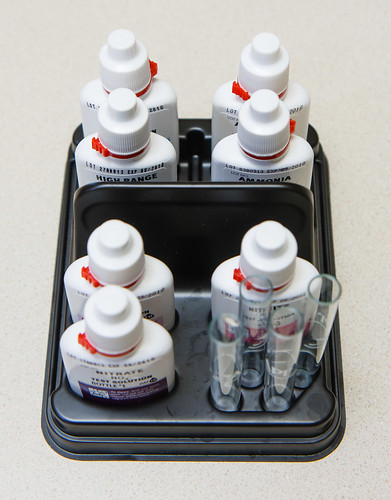
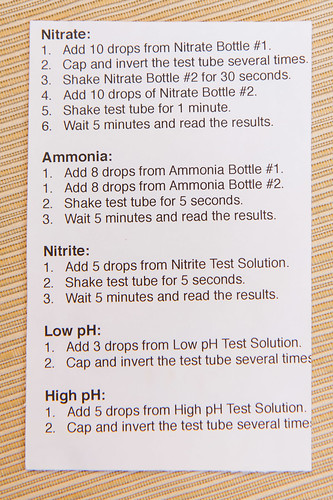
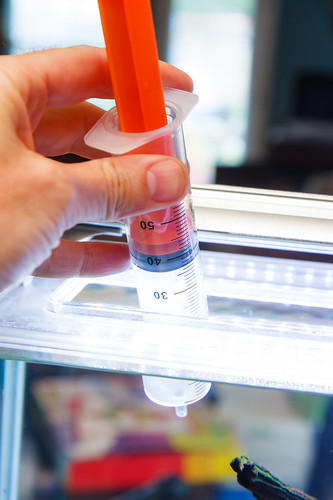
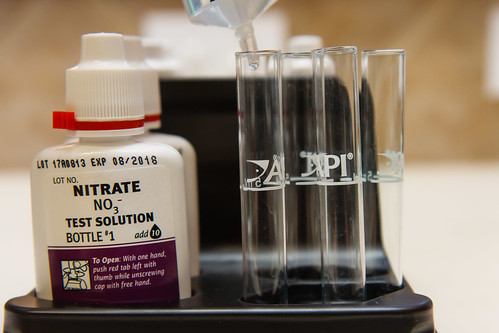
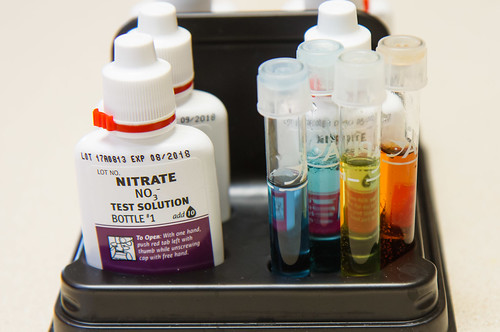
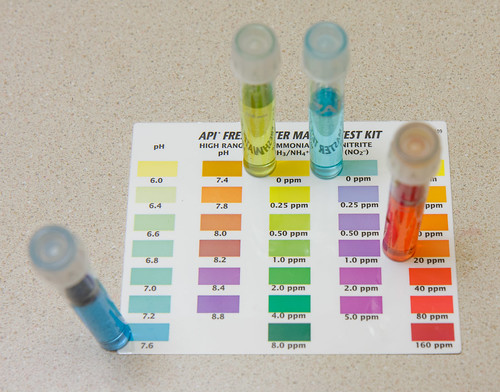
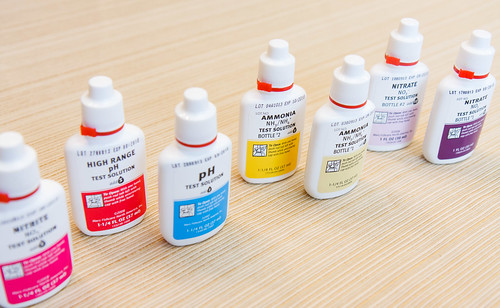

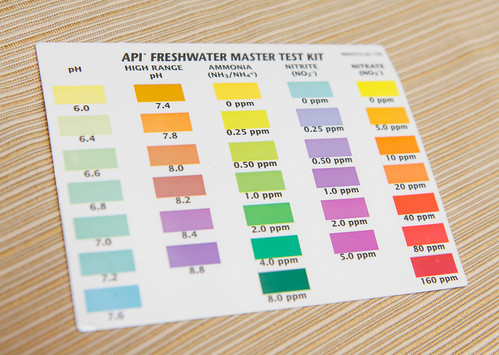
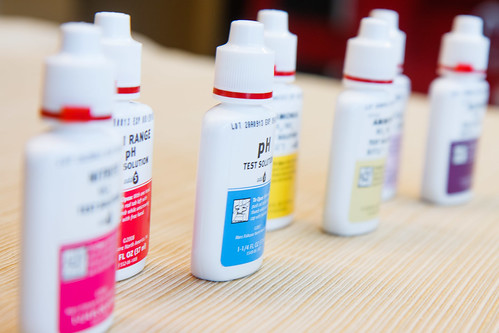

After looking at various tests out there, I was initially tempted to go w/ strip tests. But thinking how easily tests strips can go bad, I am planning on using the API Master kit as well.
Good! A little more hassle, but the liquid/test tube tests work better and last longer.
Excellent post. I was checking continuously this blog and
I’m impressed! Very useful info specially the last part
🙂 I care for such info much. I was looking for this particular info
for a very long time. Thank you and good luck.
Well thanks for checking back into my humble little site. I hope to be adding some product updates in the near future to close out the year.
What would give you a “Digital” reading of your water parameters? I’m somewhat color blind and the colors occasionally look “odd” to me and was wondering if such a thing even exists.
I know digital PH meters exist. For the other parameters (ammonia, nitrite, nitrate) if they do exist, I bet they are super expensive.
Thank you for the information and the simplified instructions, typing them from the booklet was a job I have been trying to avoid.
Do you have difficulty assessing the Nitrate values of 40ppm and 80ppm as the colors on the chart appear to be identical?
It has been a very long time since I have used a test kit, but I do agree it can be a bit hard to distinguish the Nitrate values.
One thing I learned was to use the SAME tube for each test.
I was doing Ammonia, nitrites, Nitrates tests with whatever tube my hand landed
on, thinking I had rinsed them out VERY WELL, even with a tiny tube brushing
inside, rinse rinse, one day I would have O Ammonia reading, the next day I would
have 2PPM! Recheck with another tube and it would be O again! SO I think the BLUE tint from having previously used the tube for nitrites test, even if it was
rinsed, scrubbed, rinsed really well, must of left a residue that when I used it the next day for AMmonia test, it would give me the HIgh ammonia reading. Just sharing.
Never thought about this, but I can see how that would affect the testing. Thanks for that!
All colors match the color chart except for Ammonia, it’s never the bright yellow color 0ppm like color chart. even during cycling between 0 ppm and 0.25 ppm seems to be the reading. Nitrites are 0ppm and nitrates are between 5 and 10 ppm. I’m keeping a close eye on fish they are ok..anyone else experience this?
Might be nothing – it detects ammonium as well as ammonia so ammonium might be what is making the color be off yellow a bit. (ammonium is not a problem and sometime shows up in newly added tap water.)
Hi! I also have this problem!
Tested my tank(cycling for 2 weeks) and ammonia shows somewhere between 0-0.25. never a bright yellow or light green. I’m so confused and I tested like 8 times in 2 days the nitrate seemed to be stable at 5-10ppm. Is it already cycled?
Hard to say. If NitrITE had appeared but is now at zero, there is a good chance you are cycled.
Hi, and thanks for the info. and the “Cliff Notes”!
One question I have is this: does it matter where you take the water sample from in your aquarium? Does anyone know if values vary significantly enough to matter in different parts of the tank?
Thanks!
It doesn’t matter where (in the tank) you take the sample.
Thanks for this simple introduction to the test kit and some of the things to look out for and others that might be influencing factors but not necessarily things to worry about. Very practical intro, thank you so much. It’s a huge help to me. I just got my first kit for my first aquarium and it was a bit daunting.
Glad you found it helpful – Best of luck!
Nate this was so helpful thank you. Now i have to figure out why my ammonia level is high but you really clarified a lot